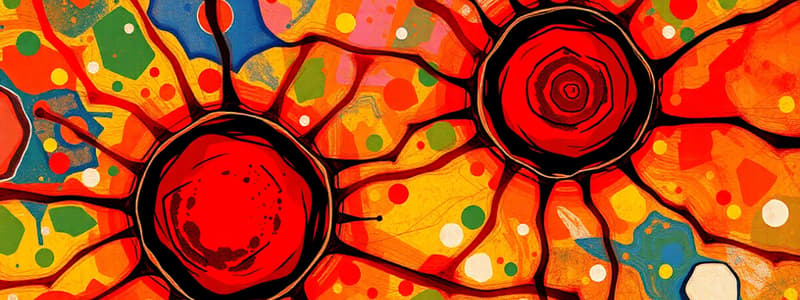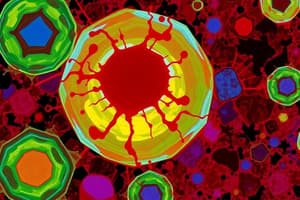Podcast
Questions and Answers
Which of the following is a physical agent that can cause cell injury?
Which of the following is a physical agent that can cause cell injury?
- Viruses
- Insecticides
- Electric shock (correct)
- Tobacco
What type of cellular adaptation involves an increase in cell size?
What type of cellular adaptation involves an increase in cell size?
- Hypertrophy (correct)
- Metaplasia
- Atrophy
- Hyperplasia
Which of the following is an example of metaplasia?
Which of the following is an example of metaplasia?
- Pseudostratified columnar epithelium changing to squamous epithelium due to cigarette smoke (correct)
- Hypertrophy of cardiac muscle due to hypertension
- Increase in kidney cell number after nephrectomy
- Skeletal muscle atrophy after paralysis
What is the main consequence of unresolved cell injury?
What is the main consequence of unresolved cell injury?
Which mechanism is involved in hypoxic cell injury?
Which mechanism is involved in hypoxic cell injury?
What defines hyperplasia in a cell context?
What defines hyperplasia in a cell context?
Which of the following statements about cellular responses to stress is true?
Which of the following statements about cellular responses to stress is true?
Which condition is an example of atrophy?
Which condition is an example of atrophy?
Which of the following is associated with an autoimmune disease?
Which of the following is associated with an autoimmune disease?
What type of cell injury results from a lack of oxygen?
What type of cell injury results from a lack of oxygen?
What type of epithelium replaces the normal ciliated columnar epithelium in response to chronic irritation?
What type of epithelium replaces the normal ciliated columnar epithelium in response to chronic irritation?
Which cellular component is primarily affected by hypoxic cell injury, leading to ATP depletion?
Which cellular component is primarily affected by hypoxic cell injury, leading to ATP depletion?
What is the first manifestation of cell injury?
What is the first manifestation of cell injury?
Which of the following best describes reversible cell injury?
Which of the following best describes reversible cell injury?
What typically leads to irreversible cell injury?
What typically leads to irreversible cell injury?
Which condition is most closely associated with decreased oxygen in the plasma?
Which condition is most closely associated with decreased oxygen in the plasma?
What phenomenon is often seen in the liver, heart, and kidney during fatty change?
What phenomenon is often seen in the liver, heart, and kidney during fatty change?
What role does lactic acid accumulation play in anaerobic glycolysis during hypoxic conditions?
What role does lactic acid accumulation play in anaerobic glycolysis during hypoxic conditions?
Hypoxic injury does NOT include which of the following causes?
Hypoxic injury does NOT include which of the following causes?
Which of the following actions results from a failure in the Na+/K+-ATPase pump during hypoxic injury?
Which of the following actions results from a failure in the Na+/K+-ATPase pump during hypoxic injury?
Flashcards
Cellular Adaptation
Cellular Adaptation
The ability of cells to adjust their structure and/or function to cope with environmental changes.
Hyperplasia
Hyperplasia
An increase in the number of cells in a tissue or organ. Think of a growing muscle.
Hypertrophy
Hypertrophy
An increase in the size of individual cells, leading to an increase in the size of the organ. Think of a heart muscle pumping harder.
Atrophy
Atrophy
Signup and view all the flashcards
Metaplasia
Metaplasia
Signup and view all the flashcards
Cell Injury
Cell Injury
Signup and view all the flashcards
Hypoxia
Hypoxia
Signup and view all the flashcards
Reversible Cell Injury
Reversible Cell Injury
Signup and view all the flashcards
Irreversible Cell Injury
Irreversible Cell Injury
Signup and view all the flashcards
Apoptosis
Apoptosis
Signup and view all the flashcards
Metaplasia in the respiratory system
Metaplasia in the respiratory system
Signup and view all the flashcards
Mitochondrial damage in reversible cell injury
Mitochondrial damage in reversible cell injury
Signup and view all the flashcards
Oxygen derived free radicals in reversible cell injury
Oxygen derived free radicals in reversible cell injury
Signup and view all the flashcards
Tissue Hypoxia
Tissue Hypoxia
Signup and view all the flashcards
Ischemia
Ischemia
Signup and view all the flashcards
Cell swelling
Cell swelling
Signup and view all the flashcards
Fatty change
Fatty change
Signup and view all the flashcards
Point of no return in cell injury
Point of no return in cell injury
Signup and view all the flashcards
Study Notes
Cell Injury - Overview
- Cells are constantly exposed to stresses
- Cells initially try to adapt
- If stress is severe or prolonged, cell injury results
Intended Learning Objectives
- List causes of cell injury
- Describe forms of adaptation with examples for each
- Recall types of cell injury
- Describe mechanisms and morphology of reversible cell injury
- Recall definition, causes and consequences of hypoxic cell injury
- Describe the mechanism of irreversible cell injury
Causes of Cellular Injury
- Physical agents: Hypoxia, mechanical trauma, burns, radiations, electric shock
- Chemical agents: Poisons (toxins), insecticides, alcohol, tobacco
- Infectious agents: Viruses, bacteria, fungi, parasites
- Immunologic reactions: Anaphylaxis, autoimmune disease
- Genetic derangements: Abnormal proteins (hemoglobinopathies), abnormal or absent enzymes (storage disorders)
Adaptation
- Hyperplasia: Increase in cell number (e.g., compensatory hyperplasia of the kidney after nephrectomy)
- Hypertrophy: Increase in cell size (e.g., hypertrophy of the left ventricle due to aortic stenosis)
- Atrophy: Decrease in cell number and/or size (e.g., skeletal muscle atrophy after paralysis)
- Metaplasia: Change of one type of cell to another type of the same category (e.g., change from columnar epithelium to squamous epithelium)
Cell Injury Classification
- Reversible: Affected cells can recover from the injury
- Irreversible: Affected cells die
Mechanisms of Reversible Cell Injury
- Disturbance in the function of:
- Cell membranes: Leads to loss of structural integrity and loss of function
- Mitochondria: Leads to decreased energy production (decreased ATP)
- Ribosomes: Leads to decreased protein synthesis
- Accumulation of oxygen-derived free radicals (e.g., H₂O₂)
Hypoxic Cell Injury
- Definition: Inadequate oxygenation of tissues
- Causes:
- Hypoxemia: Decreased amount of oxygen dissolved in plasma
- Hemoglobin-related abnormalities: Anemia
- Ischemia: Decreased arterial blood flow to tissues (usually due to atherosclerosis)
- Consequences:
- Decreased ATP synthesis
- Impaired Na+/K+-ATPase pump leading to cellular swelling
- Shift to anaerobic glycolysis leading to:
- Accumulation of lactic acid
- Decrease in intracellular pH causing denaturation of proteins and decreased activity of many enzymes
- Clumping of nuclear chromatin
- Ribosomal detachment leading to decreased protein synthesis and accumulation of lipid (fatty change)
Morphology of Reversible Cell Injury
- Cell swelling: First manifestation of cell injury, occurs when cells fail to maintain ionic and fluid homeostasis, manifests as small clear vacuoles inside the cytoplasm (also known as hydropic change)
- Fatty change: Manifested by the appearance of lipid vacuoles in the cytoplasm, often seen in the kidney, heart, and liver
Irreversible Cell Injury
- Mechanism: Persistent or severe injury (severe hypoxia or anoxia)
- Results:
- Point of no return - Injury cannot be reversed
- No intervention to save the cell
- Hallmark: Severe mitochondrial damage
Mitochondrial Damage
- Reduction in ATP production leads to mitochondrial damage, formation of high conductance channels (Mitochondrial Permeability Transition (MPT) channels)
- Release of cytochrome c into cytosol triggers cell death
Studying That Suits You
Use AI to generate personalized quizzes and flashcards to suit your learning preferences.




